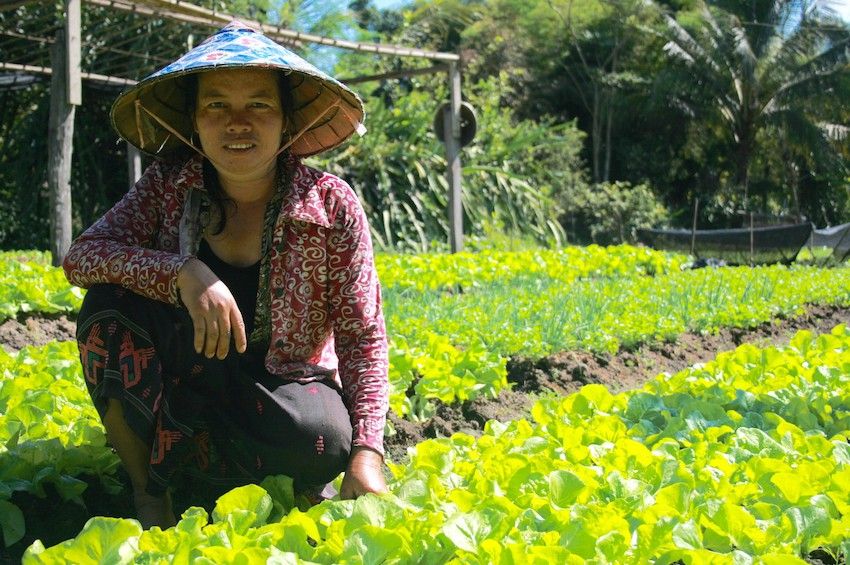A first pilot with community-based groundwater irrigation in Laos
Laos has vast surface water resources, with a very large amount per capita compared with other countries of the Greater Mekong Subregion. So, why would groundwater irrigation interest farmers in this country? The answer – because of exceptions to the general rule. Some locations are prone to seasonal water scarcity, leaving communities vulnerable to drought and limiting their options to improve food security and livelihoods through crop production in the dry season.

Such is the lot of Ekxang village, situated about 55 kilometers from Vientiane, the capital city. Its access to surface water is minimal, and most of its 236 households depend on rainfall for rice cultivation during the wet season. In the dry season, villagers also grow a wide range of vegetables and herbs (including cash crops, such as cucumber and watermelon) in home gardens and increasingly on riceland. Climate change poses a growing threat to crop production in such villages, altering wet season rainfall and making drought more common and severe.
To help find a new way forward, researchers with the International Water Management Institute (IWMI) carried out a 2-year pilot study of groundwater irrigation in Ekxang, with support from the Australian Centre for International Agricultural Development (ACIAR). Conducted in collaboration with Japan’s Institute for Global Environmental Strategies (IGES) and the Department of Irrigation, Ministry of Agriculture and Forestry (MAF), Laos, the research contributed to the CGIAR Research Program on Water, Land and Ecosystems (WLE). The results are reported in IWMI Working Paper 183, Community-managed groundwater irrigation on the Vientiane Plain of Lao PDR: Planning, implementation and findings from a pilot trial.
In a first for Laos, the pilot centered on a participatory approach, in which community members contributed to the construction and took responsibility for managing the groundwater irrigation system. The objective of the pilot was to assess the system’s technical performance and economic viability as well as the effectiveness of community-based management
Farmers at Ekxang typically irrigate crops with water from shallow wells, withdrawing it by means of buckets or pumps. In addition, they bring some surface water via a small canal from a neighboring village. But by March or April, the canal and many wells have dried out, constraining the production of cash crops or a second rice crop. Another option, and the focus of the IWMI pilot, involves the use of deeper boreholes to provide larger and more reliable supplies of groundwater. This offers farmers the possibility of expanding irrigated crop production during the dry season.
Though common elsewhere in Asia, this option has not yet caught on in Laos. It thus came as no surprise that participation in the pilot was quite modest. Farmers were wary of possible risks related to the costs of the new irrigation system. To allay these fears, the project subsidized the cost of energy for pumping water during the first year. As farmers gained experience with the high-performance electric pumps, pipe distribution system and other equipment, their trust grew, and they came to have a sense of ownership over the system.
The irrigation system turned out to be profitable but only when farmers used it for dry-season irrigation of cash crops. Growing rice under these conditions proved to be unprofitable. Increased profits, however, did not translate into increased popularity. In the pilot’s second year, with the subsidy removed, participation in the groundwater users group declined. Apart from the additional cost for pumping, another reason was a lack of household labor to manage the production of cash crops under groundwater irrigation. This, in turn, stemmed from the availability of other livelihood options (such as small businesses and wage labor), which compete with agriculture and may prove more appealing. Clearly, the future development of such systems will depend, not just on local hydrogeological conditions, but also on a better understanding of the social and economic factors that influence farmers’ decisions. New technologies could make a difference as well, such as solar pumps, which are likely to reduce farmers’ production costs.
As Laos seeks to strengthen food security and rural livelihoods, while adapting agriculture to climate change impacts, the potential of groundwater irrigation can only grow. Lessons learned from IWMI’s pilot study should prove valuable for helping realize this potential.
Read the report
Clément, C.; Vinckevleugel, J.; Pavelic, P.; Xiong, K.; Valee, L.; Sotoukee, T.; Shivakoti, B. R.; Vongsathien, K. 2018. Community-managed groundwater irrigation on the Vientiane Plain of Lao PDR: planning, implementation and findings from a pilot trial. Colombo, Sri Lanka: International Water Management Institute (IWMI). 64p. (IWMI Working Paper 183). doi: 10.5337/2018.230

